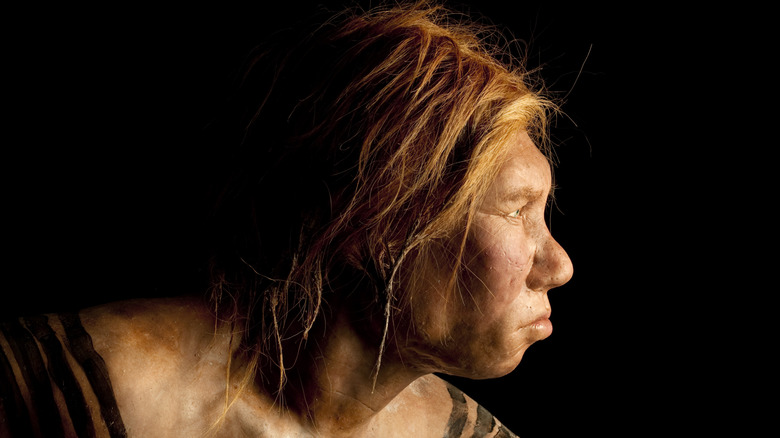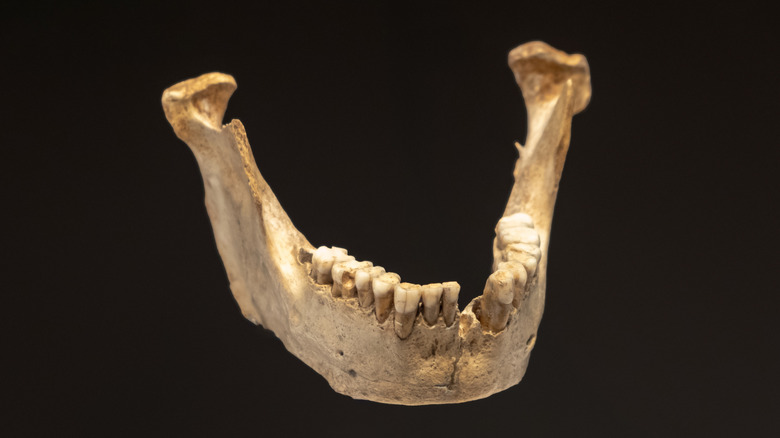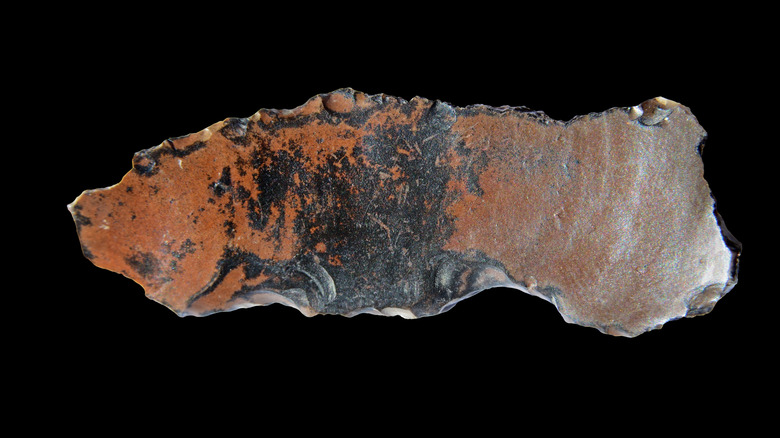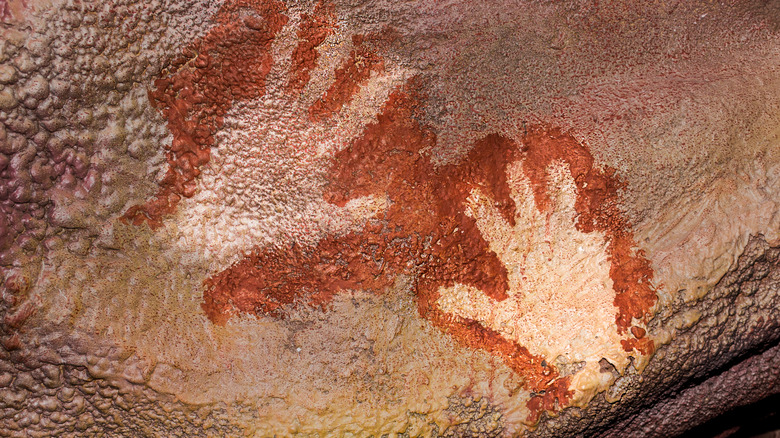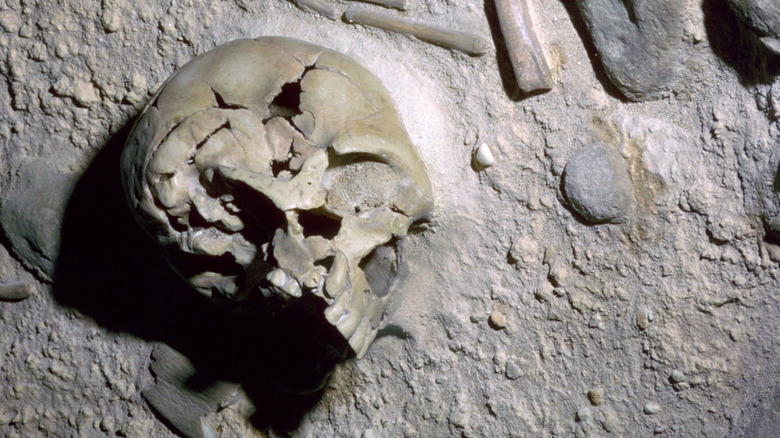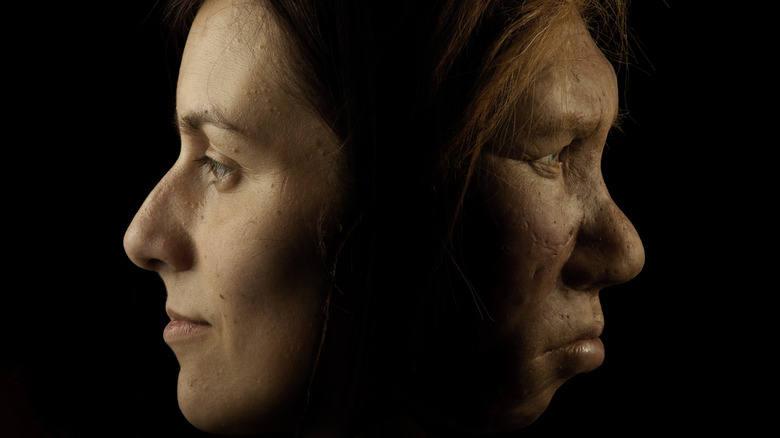What If Neanderthals Still Existed Today?
There are 18 species of penguin, over 90 different species of whale (the largest of which is over 300,000 pounds), and more than 15,000 different species of ant, but there is only one species of human: us. We Homo sapiens are the sole surviving members of our taxonomic family. It has been this way for roughly 40,000 years, but that's only a fraction of our species' history.
Homo sapiens first evolved around 300,000 years ago, and for the vast majority of our existence, we lived in a world with numerous other human species. Over millennia, they all went extinct, but one species managed to hold on longer than others. It was the last known human species besides our own to walk the Earth: Homo neanderthalensis, better known as Neanderthals.
As far as we know, Neanderthals were modern humans' closest relatives. They lived in Europe and western Asia, at times crossing paths with our own species. They had large brains and exhibited many of the same behaviors as Homo sapiens, using tools, building fires, and practicing rituals like burying the dead. Homo sapiens, however, had larger and more widespread populations, giving them strength in numbers and greater genetic diversity. Neanderthals lived in smaller, isolated communities where inbreeding was frequent, creating a weaker gene pool more vulnerable to disease. These factors, paired with climate change and direct competition from Homo sapiens brought about the Neanderthals' downfall, but if their populations had only been a bit more diverse, they might have lived to the present, making for a much different world.
There would be more linguistic diversity
Exactly how Neanderthals communicated is the subject of great scientific debate, but it appears that they did have some capacity for speech. Analyses of Neanderthal and Homo sapiens DNA, published in the journal Current Biology, revealed that our species share a gene that plays a role in speech by controlling muscles in the mouth. Another study, published in Nature, analyzed the ear bones of both modern humans and Neanderthals, and determined that we hear in the same frequency range. This means we could potentially parse each other's languages. However, it could be difficult for Homo sapiens to accurately pronounce Neanderthal languages, and vice versa, because their voice boxes were larger than ours.
If Neanderthals hadn't gone extinct, and had instead proliferated and migrated, they likely would have developed different languages in different regions, just as Homo sapiens did. This would create a whole new family of human languages in addition to our own. This could potentially lead to Neanderthal and Homo sapiens languages intersecting in the form of loanwords or even pidgin languages, which are simplified versions of speaking typically used for conducting business between parties of different language backgrounds.
There would be a wider array of technologies
Although we tend to depict them as extremely primitive, Neanderthals were more intelligent than most people think. One of the primary ways they demonstrated this intelligence was in tool design. The Neanderthal tool culture of the Middle Stone Age is also known as the Mousterian industry, named for the Le Moustier archaeological site where some of the most notable Neanderthal tool remnants have been found.
Examples of Mousterian tools include spears, hand axes, and bolas used for hunting, as well as tools for a wide range of domestic needs like scrapers for tanning hides and awls for making clothing. Many Mousterian tools were made using a distinct method called the Levallois flaking technique, in which the tool maker would carve a piece of rock into a turtle shell shape, then strike the curved side repeatedly, chipping off a series of flakes that could be used as blades or spear tips.
Neanderthals and Homo sapiens both developed their own tool cultures using different techniques, but it also appears that they shared some ideas. A 2022 study published in the journal Scientific Reports found possible evidence of tool sharing at sites where Neanderthals and Homo sapiens coexisted. If Neanderthals had not died out, this exchange of ideas could have continued to the present. Just as they developed their unique Mousterian tools during the Stone Age, they may have developed other unique industries as time advanced, opening a world of new technical achievements for both their species and ours.
Arts and entertainment would be different
Arts and entertainment are the cornerstones of human culture, and there is ample evidence to show that Neanderthals were developing such traditions themselves before they went extinct. Some of the earliest works of art ever found have been attributed to Neanderthals, including engraved animal bones found in Germany that date back 50,000 years, and cave art from France that dates back roughly 75,000 years. One particular site — the La Roche-Cotard cave in France — stands out because its walls are covered in a series of engraved lines and dots that form no particular image. It appears to be one of the first instances of what could be called abstract art, and it was created by Neanderthals. If their species had survived to the present, they may have spearheaded completely new artistic movements.
One of the most controversial impacts of Neanderthals and Homo sapiens coexisting today would be on sports. Neanderthals and modern humans would excel at completely different athletic endeavors. Physically speaking, they were generally shorter and stockier than Homo sapiens. Their truncated legs would have made them master sprinters, but perhaps not as good at long-distance running as we are. Neanderthals were more muscular than Homo sapiens as well, and thus would have likely fared better in power-based sports like weightlifting and wrestling. The issue of inequality in Neanderthal–Homo sapiens sporting matchups could potentially be a point of conflict between the species.
There would be conflicts between Neanderthals and Homo sapiens
If Neanderthals had survived to the present, it is inevitable that there would be conflict between their species and ours. To an extent, these tendencies are ingrained within us. Great apes are fiercely territorial creatures, and outside of the Homo genus, other species like chimpanzees have been observed fighting and killing each other in groups, much like the way we wage wars.
We Homo sapiens have a long and terrible history of dealing violence and death upon ourselves, and the same appears to be true of Neanderthals. A 2015 study published in the journal PLOS-One presented evidence for a Neanderthal murder case, one of the first examples of a human killing another human. Many Neanderthal remains have been found with broken arms, suggesting they may have been fending off blows near the time of their death.
Whether Neanderthals and Homo sapiens waged wars against each other is a more controversial topic. Evidence for full-scale, organized wars does not appear until after the advent of agriculture in the Neolithic Era, after Neanderthals were already extinct. However, if Neanderthals had lived up to that point and beyond, they would have found themselves competing more with Homo sapiens for territory, making violent clashes more likely. Homo sapiens had more advanced weaponry than Neanderthals, being first to develop arrows and other projectiles, so we would have had an early advantage. With better weapons and greater numbers, Homo sapiens may even have subjugated Neanderthals, absorbing them into our society, but treating them as lesser.
There might be more unity amongst Homo sapiens
If Neanderthals still existed today, the sad reality is that many Homo sapiens would likely be prejudiced against them, and vice versa. Research has repeatedly suggested that the human mind is hardwired to be biased against those different from oneself, such as this 2008 study published in Psychological Science, in which MRI was used to analyze the brain's response to a series of different human faces. When subjects were shown out-group faces, such as people of other races, or even those wearing attire from opposing sports teams, they tended to respond with high activity in the amygdala, a part of the brain associated with fear. Neanderthals, with their similar, yet distinctly different appearances, would certainly set off this same reaction in the brain, and we would probably do the same to them.
It is likely that Homo sapiens, being the species with greater numbers and larger social structures, would hold a more dominant position in global society than Neanderthals if the latter had continued to exist alongside us. We may have enslaved them and exploited their more muscular bodies for labor, and we would probably be reluctant to give them equal standing in any aspect of our society. These are all things that modern humans have done to each other throughout history, which raises an interesting question. If there was another human species to act as the overarching "other" in our society, might there be less racism and xenophobia from Homo sapiens towards other Homo sapiens?
Interspecies mating could create hybrid humans
Neanderthals no longer walk amongst us, but a small part of them has survived to the present in Homo sapiens. Genetic testing has revealed that modern humans of non-African descent have roughly 1–4% Neanderthal DNA making up their genomes. Neanderthals weren't the only extinct humans to mate with Homo sapiens either, with many people from Oceania having DNA passed down by another species called the Denisovans. These revelations speak volumes about Homo sapiens' relationship with other human species. The presence of Neanderthal DNA in modern humans is the strongest evidence of interactions between our species, and its prevalence suggests that, under the right circumstances, Homo sapiens and Neanderthals could get along and understand each other well enough to raise children together.
Interbreeding between Homo sapiens and Neanderthals may have played a role in the latter going extinct; more Neanderthals mating with Homo sapiens meant fewer were mating with each other, exacerbating their low population crisis. If Neanderthals had existed in greater numbers and survived to the present, interbreeding would have become much more widespread. Not only would we have modern humans and Neanderthals coexisting, but also hybrids of both species.
Typically, hybrid organisms are sterile — this is true of plant hybrids as well as hybrid animals like mules. However, the fact that modern humans carry Neanderthal DNA suggests that human hybrids were, to some degree, an exception. This could have opened the door to a range of human diversity beyond anything we know today, or even what we knew in the past.
